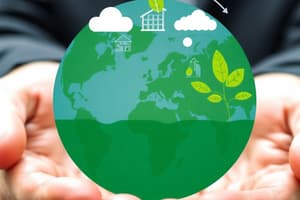Podcast
Questions and Answers
What is the primary objective of the cradle-to-cradle design approach?
What is the primary objective of the cradle-to-cradle design approach?
- To completely eliminate waste (correct)
- To reduce waste generation
- To minimize packaging in products
- To recycle materials after use
Which principle emphasizes the importance of using renewable sources for production in cradle-to-cradle design?
Which principle emphasizes the importance of using renewable sources for production in cradle-to-cradle design?
- Material reutilization
- Renewable energy (correct)
- Water stewardship
- Material health
In the context of cradle-to-cradle, what is meant by 'material reutilization'?
In the context of cradle-to-cradle, what is meant by 'material reutilization'?
- Recovering and recycling materials after their initial use (correct)
- Using secondary materials in new products
- Using materials until they are completely worn out
- Reducing the overall amount of materials used
What is one of the key benefits of implementing cradle-to-cradle design in businesses?
What is one of the key benefits of implementing cradle-to-cradle design in businesses?
What cycle in cradle-to-cradle design refers to materials that can be absorbed back into nature?
What cycle in cradle-to-cradle design refers to materials that can be absorbed back into nature?
What is a key principle of the circular economy?
What is a key principle of the circular economy?
Which of the following strategies can help businesses reduce their environmental impact?
Which of the following strategies can help businesses reduce their environmental impact?
How can businesses evaluate their economic sustainability?
How can businesses evaluate their economic sustainability?
What advantage does a circular economy provide to businesses?
What advantage does a circular economy provide to businesses?
Which of the following is NOT a principle of the circular economy?
Which of the following is NOT a principle of the circular economy?
How does the circular economy model strengthen customer relationships?
How does the circular economy model strengthen customer relationships?
What is the main goal of cradle-to-cradle design?
What is the main goal of cradle-to-cradle design?
Which of the following is a benefit of adopting sustainable practices in business?
Which of the following is a benefit of adopting sustainable practices in business?
Which principle is NOT characteristic of the circular economy?
Which principle is NOT characteristic of the circular economy?
Which of the following describes a reduced cost strategy in sustainable practices?
Which of the following describes a reduced cost strategy in sustainable practices?
Sustainable development is development that:
Sustainable development is development that:
Which of the following statements best describes a sustainable business?
Which of the following statements best describes a sustainable business?
What are the three pillars of sustainability?
What are the three pillars of sustainability?
What is social sustainability in the context of business operations?
What is social sustainability in the context of business operations?
What does environmental sustainability in the business context refer to?
What does environmental sustainability in the business context refer to?
What does economic sustainability refer to?
What does economic sustainability refer to?
What best describes a linear economy?
What best describes a linear economy?
What is a linear economy?
What is a linear economy?
Canada alone generates over _____ of municipal solid waste per year, most of which is non-degradable materials.
Canada alone generates over _____ of municipal solid waste per year, most of which is non-degradable materials.
What is a circular economy?
What is a circular economy?
What is a circular economy?
What is a circular economy?
How can businesses benefit from the circular economy model?
How can businesses benefit from the circular economy model?
What does the term 'cradle-to-grave' refer to in sustainability?
What does the term 'cradle-to-grave' refer to in sustainability?
What does the term 'cradle to cradle' refer to in sustainability?
What does the term 'cradle to cradle' refer to in sustainability?
Which of the following are principles of cradle-to-cradle sustainability? (Select all that apply)
Which of the following are principles of cradle-to-cradle sustainability? (Select all that apply)
Which of the following are design principles of cradle-to-cradle sustainability? (Select all that apply)
Which of the following are design principles of cradle-to-cradle sustainability? (Select all that apply)
Which of the following best describes material health in the Cradle to Cradle sustainability framework?
Which of the following best describes material health in the Cradle to Cradle sustainability framework?
What is a key principle of water stewardship in sustainability?
What is a key principle of water stewardship in sustainability?
What is a key principle of social responsibility in cradle to cradle sustainability?
What is a key principle of social responsibility in cradle to cradle sustainability?
In a cradle-to-cradle model, products must be designed to ensure that all materials can be classified into 1 of 2 cycles:
In a cradle-to-cradle model, products must be designed to ensure that all materials can be classified into 1 of 2 cycles:
What is the biological cycle in the cradle to cradle model?
What is the biological cycle in the cradle to cradle model?
Which of the following materials are examples of the biological cycle? (Select all that apply)
Which of the following materials are examples of the biological cycle? (Select all that apply)
What does the technical cycle in the cradle to cradle model represent?
What does the technical cycle in the cradle to cradle model represent?
What is the technical cycle defined by?
What is the technical cycle defined by?
Upcycling is defined as which of the following?
Upcycling is defined as which of the following?
Biomimicry is defined by which of the following statements?
Biomimicry is defined by which of the following statements?
What does the life cycle assessment (LCA) evaluate?
What does the life cycle assessment (LCA) evaluate?
What are the four stages of a life cycle assessment?
What are the four stages of a life cycle assessment?
What does the first stage of the life cycle assessment focus on?
What does the first stage of the life cycle assessment focus on?
Inventory analysis in the life cycle assessment focuses on which of the following aspects?
Inventory analysis in the life cycle assessment focuses on which of the following aspects?
What does impact assessment in the life cycle assessment examine?
What does impact assessment in the life cycle assessment examine?
What does the interpretation of data stage in the life cycle assessment focus on?
What does the interpretation of data stage in the life cycle assessment focus on?
What are some benefits of conducting a life cycle assessment (LCA) for businesses? (Select all that apply)
What are some benefits of conducting a life cycle assessment (LCA) for businesses? (Select all that apply)
Supply chain sustainability is defined as:
Supply chain sustainability is defined as:
Which of the following statements about product stewardship are correct? (Select all that apply)
Which of the following statements about product stewardship are correct? (Select all that apply)
What is extended producer responsibility?
What is extended producer responsibility?
Today, 5 Canadian provinces (BC, Saskatchewan, Manitoba, Ontario, and Quebec) have established a form of what?
Today, 5 Canadian provinces (BC, Saskatchewan, Manitoba, Ontario, and Quebec) have established a form of what?
What are the benefits of extended producer responsibility (EPR)? (Select all that apply)
What are the benefits of extended producer responsibility (EPR)? (Select all that apply)
What is green marketing?
What is green marketing?
What is the primary purpose of a certified B Corporation?
What is the primary purpose of a certified B Corporation?
What are Certified B Corps?
What are Certified B Corps?
What is greenwashing?
What is greenwashing?
What is a hidden trade-off in greenwashing?
What is a hidden trade-off in greenwashing?
What does a lack of proof in greenwashing refer to?
What does a lack of proof in greenwashing refer to?
Vagueness in greenwashing refers to which of the following?
Vagueness in greenwashing refers to which of the following?
Flashcards
Economic Sustainability
Economic Sustainability
Managing business operations for long-term growth and profitability, using resources responsibly, and minimizing negative impacts on the environment and society.
Linear Economy
Linear Economy
A traditional economic model where raw materials are used to make products, which are then discarded as waste.
Circular Economy
Circular Economy
An economic system aiming to eliminate waste and pollution, keeping resources in use longer, and regenerating natural systems.
Circular Economy Principles
Circular Economy Principles
Signup and view all the flashcards
Business Benefits of Circular Economy
Business Benefits of Circular Economy
Signup and view all the flashcards
Cradle-to-Cradle Design
Cradle-to-Cradle Design
Signup and view all the flashcards
Material Health (Cradle-to-Cradle)
Material Health (Cradle-to-Cradle)
Signup and view all the flashcards
Material Reutilization (Cradle-to-Cradle)
Material Reutilization (Cradle-to-Cradle)
Signup and view all the flashcards
Biological Cycle (Cradle-to-Cradle)
Biological Cycle (Cradle-to-Cradle)
Signup and view all the flashcards
Closed-Loop Systems (Cradle-to-Cradle)
Closed-Loop Systems (Cradle-to-Cradle)
Signup and view all the flashcards
Circular Economy Model
Circular Economy Model
Signup and view all the flashcards
Sustainable Product Design
Sustainable Product Design
Signup and view all the flashcards
Study Notes
Integrating Sustainability into Operations
- Societal expectations and consumer awareness of environmental costs are driving organizations to establish sustainable operations.
- Sustainable development meets present needs without compromising future generations.
- Sustainable businesses operate without negatively impacting the environment, community, or society.
Three Dimensions of Sustainability
- Social Sustainability: Manages operations to positively impact employee, customer, community, and societal well-being. Includes diversity, equity, community engagement, ethical procurement, and philanthropy.
- Environmental Sustainability: Minimizes negative impacts on the natural environment, focusing on reducing emissions, minimizing waste, using less energy, and mitigating environmentally damaging effects.
- Economic Sustainability: Promotes long-term growth and profitability by efficiently using resources, while minimizing environmental and societal harm. This includes conducting business responsibly without undue harm to the environment and society.
Three Pillars of Sustainability
- Consideration of social, environmental, and economic impacts is crucial for implementing sustainability into business operations. This shifts from a focus on just profits to a more comprehensive view of operations.
Circular Economy Model
- Businesses can benefit from a circular economy model by reducing costs (fewer materials, lower energy costs, reduced waste management), boosting resilience against raw material volatility, and strengthening customer relationships. Positive branding is also a benefit.
Life Cycle Assessment (LCA)
- LCA assesses the environmental impact of a product, process, or service across its entire life cycle, and measures environmental impact from cradle-to-grave/or cradle-to-cradle.
- Businesses use LCA to evaluate environmental performance, identify and prioritize improvement areas.
Sustainable Supply Chain Management
- Supply chain sustainability considers environmental, social, and economic impacts, from raw materials to delivery.
- This includes examining logistics, operational performance, environmental factors (climate change, water security), and social factors (human rights, fair labor practices).
- Sustainable supply chain strategies target minimizing energy use and waste, and using renewable alternatives for water and greenhouse gases.
Product Stewardship and EPR
- Product Stewardship is an environmental management strategy that minimizes the product's impact from raw materials through disposal.
- Extended Producer Responsibility (EPR) is an environmental policy that places environmental responsibility for a product's life cycle, including post-consumer stage, on the manufacturer.
- EPR incentivizes producers to shift to sustainable design and practices.
Green Marketing Pitfalls
- Greenwashing involves misleading consumers with claims of sustainability. Pitfalls include hidden trade-offs, lack of proof, and vagueness in environmental claims.
Studying That Suits You
Use AI to generate personalized quizzes and flashcards to suit your learning preferences.




